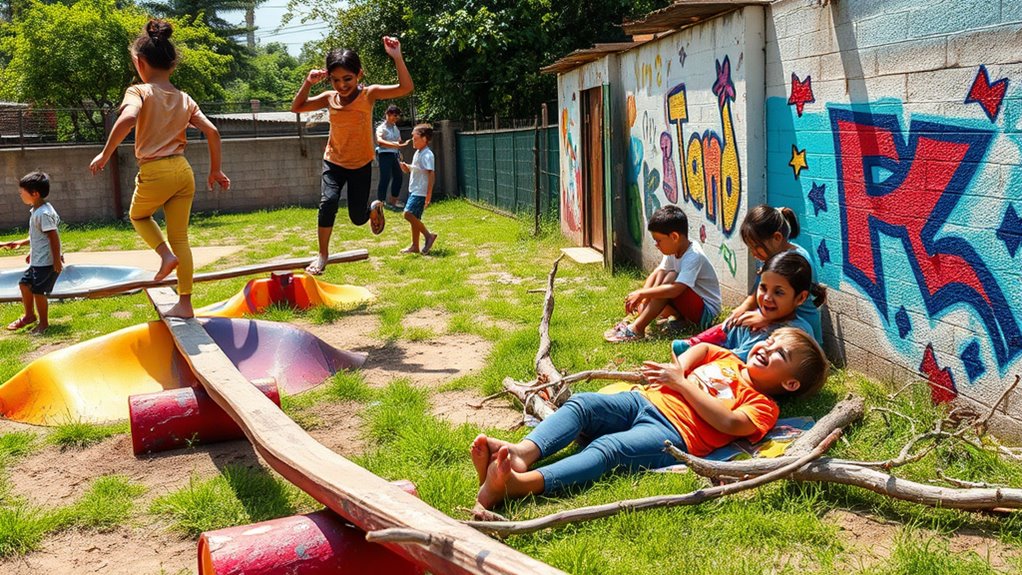To cultivate resilient kids, help them view challenges as growth opportunities. Encourage them to take on new tasks and embrace failure as part of learning. Share your own experiences with overcoming setbacks and demonstrate positive coping strategies. Foster strong relationships and teach them to express feelings openly. Celebrate their efforts, no matter how small, and incorporate mindfulness practices to enhance stress management. If you’re curious about further strategies, there’s more to explore.
Key Takeaways
- Encourage children to view challenges as opportunities for growth, fostering a mindset that embraces adaptability.
- Model resilience by sharing personal experiences and coping strategies during setbacks, demonstrating positive attitudes toward adversity.
- Promote problem-solving skills by asking open-ended questions, empowering children to find their own solutions to challenges.
- Foster strong relationships and emotional communication, teaching children to seek support and express their feelings during tough times.
- Celebrate efforts and reinforce the value of perseverance, helping children understand that adaptability stems from continuous trying and learning.

How can some kids bounce back from challenges while others struggle? It’s a question many parents grapple with as they watch their children navigate the ups and downs of life. The answer often lies in the ability to foster resilience. Resilient kids possess a unique capacity to adapt, learn, and grow from setbacks, and you can play a key role in nurturing this quality.
Start by creating an environment where challenges are viewed as opportunities. Encourage your kids to take on new tasks, whether it’s learning a musical instrument or tackling a difficult math problem. Let them know that failure’s a part of the process, and it’s okay to stumble along the way. When they face difficulties, emphasize the importance of perseverance. Remind them that overcoming obstacles leads to personal growth and builds character.
Create an environment where challenges are opportunities, teaching kids that failure is part of growth and perseverance builds character.
Modeling resilience yourself is essential. Kids learn a lot from your behavior. When you encounter challenges, share your experiences with them. Talk about the strategies you use to cope, how you manage stress, and what you’ve learned from your setbacks. When they see you handling adversity with a positive mindset, they’re more likely to adopt similar attitudes. Your example can be a powerful motivator for them to embrace challenges.
Encourage problem-solving skills. When your child faces a problem, instead of immediately providing a solution, ask open-ended questions. This approach helps them think critically and come up with their own solutions. It empowers them to take ownership of their challenges and builds confidence. You might say, “What do you think you can do to fix this?” or “How might you approach this differently next time?”
Fostering strong relationships is also important. Encourage your kids to build connections with friends and family. Supportive relationships provide a safety net during tough times. Teach them to communicate their feelings and seek help when needed. Knowing they’re not alone in facing challenges can considerably boost their resilience.
Finally, celebrate their efforts and achievements, no matter how small. Positive reinforcement encourages them to keep trying. Acknowledge their hard work, and remind them that growth often comes from effort rather than just success. Additionally, incorporating mindfulness practices can further enhance their ability to cope with stress and reduce the likelihood of small errors.
Frequently Asked Questions
What Are the Signs of Resilience in Children?
You can spot signs of resilience in children through their ability to cope with setbacks, adapt to changes, and maintain a positive outlook. They often show persistence in the face of challenges, bounce back quickly after disappointments, and seek help when needed. You’ll notice they take responsibility for their actions and learn from mistakes. Their willingness to try new things, despite fear or uncertainty, also indicates a strong foundation of resilience.
How Do I Measure My Child’s Adaptability?
To measure your child’s adaptability, observe how they handle changes or unexpected situations. Notice if they adjust their plans without becoming overly frustrated. Pay attention to their willingness to try new activities and interact with different people. You can also ask them about their feelings when faced with change; their insights can reveal how well they adapt. Ultimately, guide them through challenges, and see how they respond and learn from those experiences.
Are There Specific Activities to Boost Resilience?
You can boost your child’s resilience by engaging them in activities like obstacle courses, where they’ll face challenges and learn to adapt. Try team sports to foster collaboration and problem-solving. Encourage imaginative play, allowing them to navigate different scenarios. Even simple tasks, like cooking together, can build confidence as they learn to handle unexpected situations. Each experience provides them with tools to bounce back stronger when life throws a curveball.
Can Resilience Be Taught to Older Children?
Yes, resilience can definitely be taught to older children. You can encourage them to face challenges head-on by providing opportunities for problem-solving and decision-making. Help them reflect on their experiences, emphasizing what they learned from setbacks. Encourage a growth mindset by praising effort over outcomes, and model resilience in your own life. Engage in discussions about emotions, teaching them how to cope and adapt. Your guidance can considerably impact their ability to bounce back.
What Role Do Teachers Play in Fostering Resilience?
Teachers play a vital role in fostering resilience by creating a supportive environment where you feel safe to take risks and make mistakes. They model perseverance and problem-solving skills, encouraging you to face challenges head-on. By providing constructive feedback and promoting a growth mindset, teachers help you understand that failure is a part of learning. Through consistent encouragement and guidance, they empower you to develop the adaptability needed to thrive in various situations.
Conclusion
In a world that’s constantly changing, cultivating resilience in kids is more important than ever. Did you know that 70% of resilient children are more likely to succeed academically and socially? By encouraging adaptability, you’re not just helping them cope with challenges; you’re equipping them with the skills to thrive. So, embrace flexibility in their routines and teach problem-solving strategies. With your support, they’ll grow into confident, resilient individuals ready to face whatever life throws their way.









